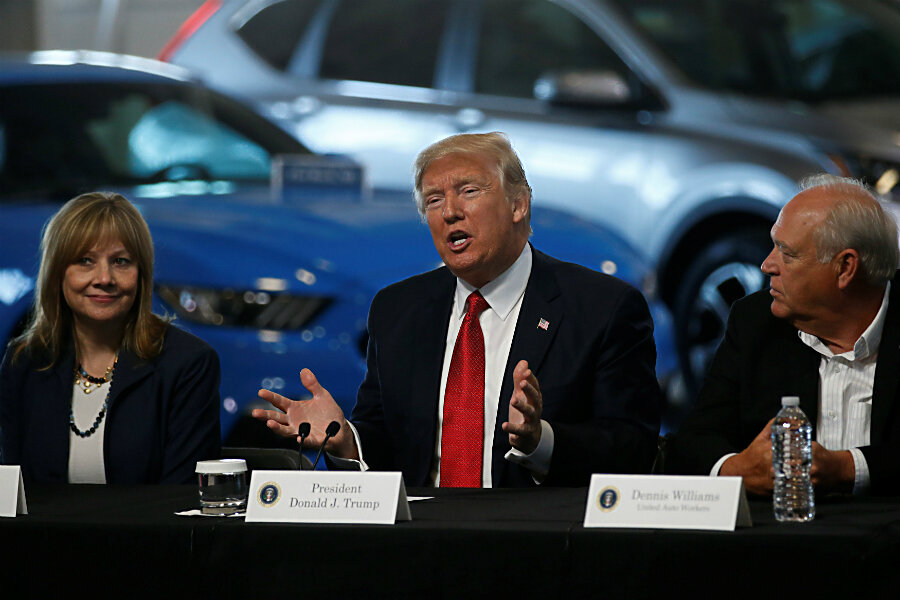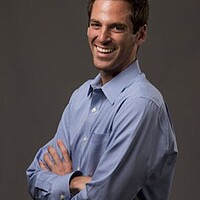Trump mileage policy could put carmaker innovation at risk
Loading...
| Washington
A common refrain among climate-policy experts as the Trump presidency dawned has been that the private sector and states are poised to lead as the federal government pulls back on efforts to reduce carbon emissions.
The rubber met the road on that theory Wednesday.
Following pleas from major automakers, President Trump said in Ypsilanti, Mich., that his administration will reconsider the Obama Environmental Protection Agency’s January determination that car companies could meet a 54.5 mile-per-gallon standards for average vehicle fuel economy by 2025.
The move – which could pave the way for the Transportation Department, which administers the rule, to set a lower standard over the next year – highlights that in some industries at least, it’s an open question whether ambitions related to climate change can be sustained if the White House is inclined to back off on the issue.
“The question is going to be about the degree to which they really plow forward on this,” says Sam Ori, executive director at the Energy Policy Institute at the University of Chicago. “It does kind of send a signal about the lack of policy stability that I think is not a good signal to send — that policy is so malleable on something like this. And that’s something they will probably have in mind going forward, that these things are negotiable.”
The car-and-climate connection
America’s fuel-economy standard is significant for climate change. Transportation is now the leading sector for greenhouse gas emissions in the United States. The lower the so-called Corporate Average Fuel Economy (CAFE) standard, the smaller will be the reductions carbon dioxide emissions from vehicles.
Car manufacturers and the Trump administration have stopped short of saying they’re seeking a rollback of official target of 54.5 m.p.g. (In practice, with a mix of credits and driving on real roads rather than undergoing indoor tests, the actual fuel economy would be 40 miles per gallon or less). They say they want to collect more data to see whether the final targets are achievable, arguing the Obama EPA rushed its judgment by seeking to finalize a “mid-term evaluation” of the policy too far ahead of an April 2018 deadline.
The review was designed as a reassessment period to check whether auto companies were on track to meet the long-term projections. The manufacturers say they aren’t.
“The auto industry rightly called foul,” a senior White House official said in a call with reporters. “We’re going to get this agreement back on track.”
The National Highway Traffic Safety Administration, or NHTSA, said last week that manufacturers may fall short of fuel-economy standards for the first time since 2004. The EPA, NHTSA, and the California Air Resources Board all play a role in the program to track new-car fuel economy.
The automobile industry has pointed to underwhelming electric-vehicle sales as a factor. But there are different standards for various car types, says Janet McCabe, the former EPA air chief under President Barack Obama. So while selling markedly more electric vehicles would certainly help, it wasn’t a necessary condition for achieving the standard. The CAFE standard wouldn’t require a massive electric vehicle buildout, the EPA and its advocates have argued.
Changing CAFE standards isn’t a quick process. It requires formal rulemaking.
'Not necessarily ... dramatic changes'
And even if the Trump administration dials back the target, that doesn't mean automakers would pull back on research and development, as gas prices could spike and consumer attitudes shift, says Jeff Holmstead, the EPA air chief under President George W. Bush.
"My read is that they are not necessarily looking at dramatic changes," Mr. Holmstead says of the CAFE standards. Rather than lowering fuel-economy targets, auto companies could seek more ways to earn efficiency credits. "I think they would just like some more flexibility and some other ways that they can meet these standards."
Moreover, other policies remain intact to keep the auto industry moving toward more fuel efficient vehicles. The main one is California’s waiver for stricter standards, which 13 other states follow, accounting for about 40 percent of the vehicle market. California is taking that even further with a zero-emission vehicle standard that could boost electric car sales — nine other states have signed onto the program. Also, there’s a $7,500 federal consumer credit for buying electric cars, and many car companies haven’t seen even half the available credits (200,000 per carmaker) used.
Electric cars unlike solar panels
In another arena, clean energy, policy has put wind and solar power on a path toward self-sustaining momentum, says Mr. Ori at the University of Chicago. A combination of federal research and development spending, tax incentives, and state renewable electricity mandates have lowered up-front costs and maintained growth in the sector, challenging conventional fuels like coal.
But the transportation sector is different – far more dependent on policy for its outlook. Gasoline is the dominant fuel source and lacks cost-competitive rivals. While battery costs for electric vehicles are coming down, charging infrastructure is lacking and making sizable gains in battery storage is messy.
It’s not that the market for plug-in cars will evaporate, but “it’s a question of speed and scale,” says Sue Reid, vice president of climate and energy programs at business sustainability group Ceres. “With the right policies and incentives in place, you can ramp up electric vehicles much more quickly.”
More federal policies at stake
Many policies that support fuel efficiency and alternative-fuel vehicles are under threat.
EPA Administrator Scott Pruitt suggested in his confirmation hearing that the agency might review whether California can continue its vehicle program.
President Trump’s budget is expected to take an axe to the Energy Department’s Energy Efficiency and Renewable Energy division, which controls the federal electric vehicle incentive and research programs on producing cars with lighter materials. On top of that, a coordinated effort spearheaded by groups aligned with the Koch political action network aims to kill state electric vehicle incentives.
“It’s hard to get people focused on the future, and governments have a long history of waiting until the last minute – until it’s too late or just before it’s too late,” says Bruce Belzowski, managing director of the University of Michigan Transportation Research Institute’s automotive futures group.
Automakers say they’re committed to fuel efficiency and alternative-fuel vehicles.
Chevrolet is pushing its new long-range Bolt electric vehicle, which can travel 238 miles on a single charge and costs under $30,000 with a federal credit. Ford Motor Co. in January unveiled a $4.5 billion plan for investing in electric vehicles, with plans to build 13 new models over 10 years. General Motors and Honda Motor Co. are combining on a hydrogen fuel cell manufacturing facility in Michigan.
Still, car companies contend they may not meet the long-term CAFE standard because not enough customers are buying electric and hybrid cars, which account for just 3.5 percent of sales. They disagree with the EPA that the CAFE standards can be met without substantially more electric vehicle purchases.
How policies can affect demand
“Vehicle sales are tied to market realities. We have the [zero-emission vehicles] and more fuel efficient models. We don’t have the consumer demand,” Daniel Gage, a spokesman with the Alliance of Auto Manufacturers, says in an email. “Automakers are in. We’re invested in these technologies. The question is are our government partners, regardless of where CAFE eventually ends up?”
Mr. Gage says better policy would be needed to promote demand of more efficient and alternative-fuel vehicles. Building more charging infrastructure and devoting HOV lane space to zero-emission vehicles would be one big step. Broad customer education and awareness efforts, rather than brand-specific advertising, might also encourage sales.
Electric vehicles have underperformed compared with the initial CAFE analysis. That’s partly because gasoline prices unexpectedly plummeted to around $2 per gallon as oil prices more than halved in 2014 and 2015. The initial EPA analysis, meanwhile, rested on something closer to $4 per gallon, which it assumed would shift car-buying habits. As a result, SUV and truck sales ticked upward while electric vehicle and other more fuel-efficient varieties stalled.
The emergence of the Bolt, which will roll off the assembly line this year, proves that automakers can build affordable alternative-fuel vehicles at a low price, says Mr. Belzowski at the University of Michigan. And Tesla Inc., which didn’t ask for a reset of the mid-term review, netted 400,000 deposits for its Model 3, priced at $35,000 before the federal tax credit.
In fact, the progress on bringing down cost and increasing battery range makes the automakers’ CAFE complaints puzzling, Belzowski says.
“It sounds like the manufacturers are trying to either have it both ways or talking out of both sides of their mouths,” Belzowski says. “They’re saying, ‘Yes, we can do this and it’s great stuff, but it’s also really expensive and people aren’t going to want it.’ So you start to wonder, are the manufacturers being genuine?”






